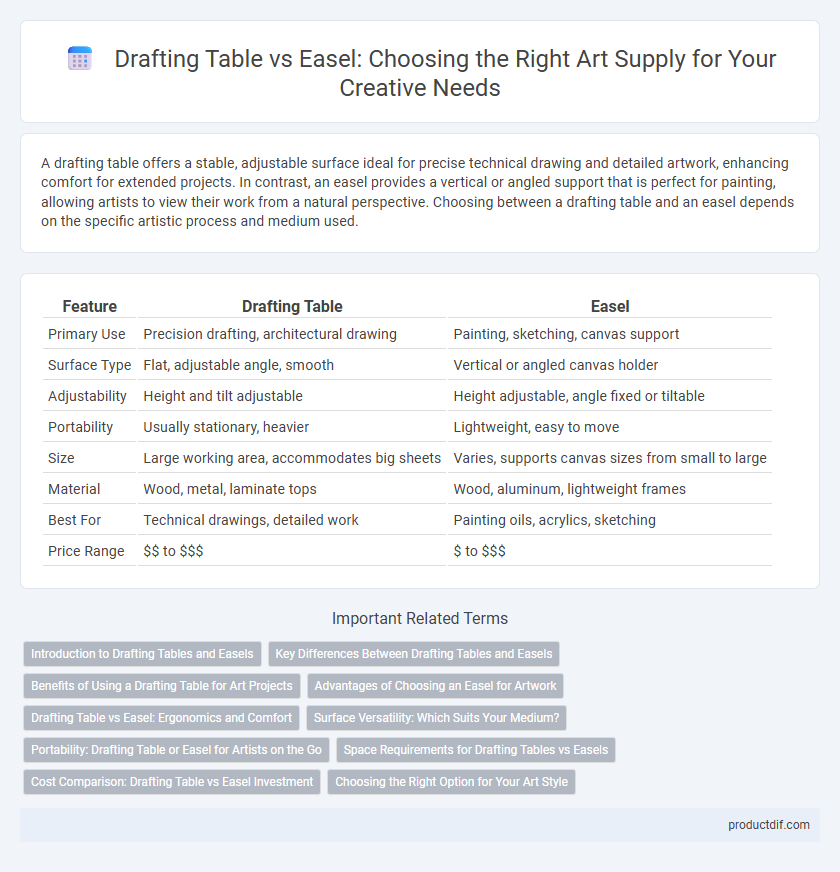A drafting table offers a stable, adjustable surface ideal for precise technical drawing and detailed artwork, enhancing comfort for extended projects. In contrast, an easel provides a vertical or angled support that is perfect for painting, allowing artists to view their work from a natural perspective. Choosing between a drafting table and an easel depends on the specific artistic process and medium used.
Table of Comparison
| Feature | Drafting Table | Easel |
|---|---|---|
| Primary Use | Precision drafting, architectural drawing | Painting, sketching, canvas support |
| Surface Type | Flat, adjustable angle, smooth | Vertical or angled canvas holder |
| Adjustability | Height and tilt adjustable | Height adjustable, angle fixed or tiltable |
| Portability | Usually stationary, heavier | Lightweight, easy to move |
| Size | Large working area, accommodates big sheets | Varies, supports canvas sizes from small to large |
| Material | Wood, metal, laminate tops | Wood, aluminum, lightweight frames |
| Best For | Technical drawings, detailed work | Painting oils, acrylics, sketching |
| Price Range | $$ to $$$ | $ to $$$ |
Introduction to Drafting Tables and Easels
Drafting tables offer adjustable surfaces designed for precision tasks such as architectural drawings, technical designs, and detailed illustrations, typically featuring tiltable tops and integrated measuring tools. Easels provide an upright support structure mainly used for painting and sketching, allowing artists to work comfortably at various heights while showcasing the artwork during creation. Both tools cater to different artistic needs, with drafting tables emphasizing accuracy and easels focusing on visual accessibility and ease of brush movement.
Key Differences Between Drafting Tables and Easels
Drafting tables feature adjustable flat surfaces designed for precise architectural or technical drawing, emphasizing ergonomic angles and stability for detailed work. Easels are primarily vertical or slightly inclined stands supporting canvases, optimized for painting and allowing easy access to the artwork's entire surface. While drafting tables prioritize flatness and angle customization for two-dimensional drafting, easels focus on elevation and flexibility to accommodate various canvas sizes and artistic techniques.
Benefits of Using a Drafting Table for Art Projects
A drafting table offers adjustable angles and a stable surface, enhancing precision and comfort during detailed art projects. Its ergonomic design reduces strain, allowing artists to work longer with improved posture. The integrated storage compartments also keep art supplies organized and within easy reach, streamlining the creative process.
Advantages of Choosing an Easel for Artwork
An easel offers superior flexibility in positioning, allowing artists to adjust the angle and height for optimal comfort and precision during painting or sketching. Its vertical orientation helps prevent glare and distortion, enhancing visual accuracy and detail in artwork. Easels also encourage a more natural posture, reducing strain and promoting longer, more productive creative sessions.
Drafting Table vs Easel: Ergonomics and Comfort
Drafting tables offer superior ergonomics and comfort by providing adjustable angles and heights that support proper posture during detailed design work, reducing strain on the back and neck. Easels, while versatile for painting, often require standing or leaning, which can lead to fatigue during prolonged use. For artists seeking comfort during long creative sessions, drafting tables are ergonomically optimized to minimize physical discomfort and enhance productivity.
Surface Versatility: Which Suits Your Medium?
Drafting tables offer a flat, adjustable surface ideal for precision tasks like technical drawing, drafting, and detailed sketching, accommodating mediums such as pencil, ink, and markers. Easels provide an angled or vertical support perfect for painting and mixed media, enhancing visibility and ergonomics for canvases or heavy papers. Choosing between a drafting table and an easel depends on your primary medium and preferred working posture to maximize surface versatility and creative efficiency.
Portability: Drafting Table or Easel for Artists on the Go
Easels offer superior portability for artists on the go due to their lightweight design and foldable structure, making them easy to carry and set up in various locations. Drafting tables, though adjustable and spacious, are generally bulkier and less convenient for transport, often requiring a dedicated workspace. Artists prioritizing mobility typically prefer easels, especially portable or field easels, for outdoor sketching and plein air painting.
Space Requirements for Drafting Tables vs Easels
Drafting tables typically demand a larger footprint due to their adjustable surfaces and integrated storage compartments, making them ideal for spacious studios. Easels require significantly less floor space and offer flexible placement options, suitable for smaller or multifunctional rooms. Choosing between the two depends on available space and workflow needs, with drafting tables providing stability and precision, while easels emphasize portability and compactness.
Cost Comparison: Drafting Table vs Easel Investment
Drafting tables typically cost between $150 and $1,000, offering adjustable surfaces ideal for detailed architectural or engineering drawings, while easels range from $50 to $500, suitable for painting and general sketching tasks. The higher price of drafting tables reflects their specialized design and ergonomic features, making them a long-term investment for professionals prioritizing precision and comfort. Easels provide a more budget-friendly option for artists seeking portability and versatility in various studio and outdoor environments.
Choosing the Right Option for Your Art Style
Selecting between a drafting table and an easel depends largely on your art style and medium. Drafting tables offer adjustable angles and flat surfaces ideal for precision work, technical drawings, and detailed sketches, while easels provide vertical support perfect for painting on canvases and creating dynamic brush strokes. Assessing your preferred techniques and workspace needs ensures you choose the right tool to enhance creativity and ergonomics.
Drafting Table vs Easel Infographic

 productdif.com
productdif.com